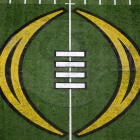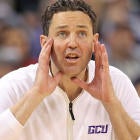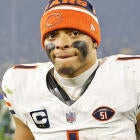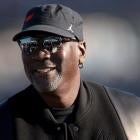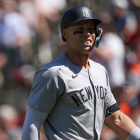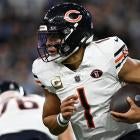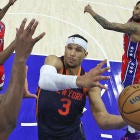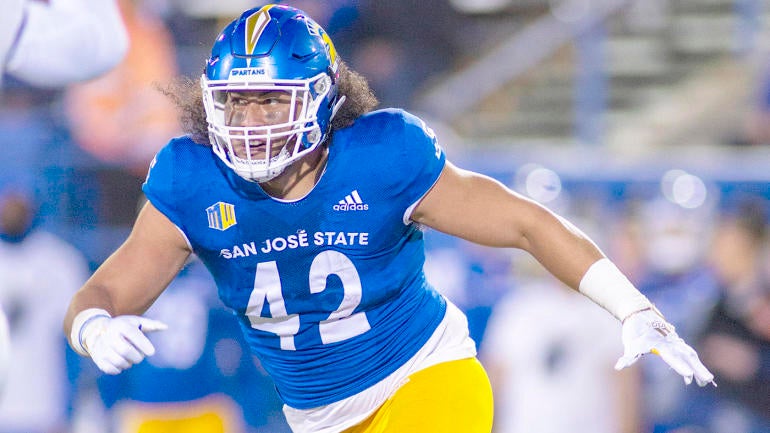
When watching tape to prepare for the 2023 NFL Draft, one of the things I love to see in a player is how violent they are playing the game. We know it's a violent game, but there are some guys who play with a little more of the nasty than others.
One of those guys is San Jose State edge player Viliami Fehoko. There isn't a battle he backs down from, which is why he is such an intriguing prospect. When he attacks, he does so with brute power and force, often times knocking the opposition back or stopping them clear in their tracks as they try to block him.
At 6-foot-4 and 276 pounds, with 33-inch arms, he played a multitude of positions for the Spartans, lining up inside as well as in a stand-up rush position. That versatility, coupled with his ability to rush the passer from all spots and to play with a toughness scouts love, are why he's the captain of this year's Better-Than team, a team made up of players I like more than the scouts.
Being the captain has prestige of sorts. Guys who were captains in past years were Lavonte David, Jason Pierre-Paul, Jimmie Ward and Grady Jarrett.
Players who have been on the team in the past who were drafted after the first round, only to go on to be star players, were Chiefs tight end Travis Kelce, Cowboys quarterback Dak Prescott, Bills receiver Stefon Diggs, 49ers tight end George Kittle and Vikings edge player Za'Darius Smith. Seahawks receiver Tyler Lockett, Jets receiver Allen Lazard and Vikings right tackle Brian O'Neill were also on the team in the past.
That doesn't mean there haven't been misses. Who can forget when quarterback Christian Ponder was my captain or when former Patriots corner JoeJuan Williams, who hasn't come close to expectations, was the captain in 2019 and was a second-round bust.
Fehoko has to hope he falls in line with the captains that made it. I think he will. Fehoko finished with 23 sacks in his San Jose State career, with nine last season, getting them from a variety of spots. The one thing that stands out about his game in addition to his tough play are his pass-rush moves and good hands. That's usually a problem for young players, but it's a strength of his game. His spin moves are among the best in this draft.
Fehoko isn't the type of player who will beat a tackle with pure speed, but he can get to the quarterback thanks to his power and pass-rush techniques. With the way teams are looking for pass-rushers who can move inside on third down, his value should be even greater the way he was used by the Spartans in that role at times.
But the best trait is his violent play. Even on every football field, where it's a part of every play, he stands out. That matters, which is why he's going to be a long-time player in the NFL and why he's the captain of this team.
There is one change to this Better-Than team from past years: I liked so many Day 2 and Day 3 players this year that I've added five move players to the team to give me a total of 25. Here are the other 24 to go with Fehoko.
For more draft content, check out our latest prospect rankings and mock drafts, as well as our new weekly podcast, "With the First Pick," featuring former Vikings general manager Rick Spielman. (Check out the latest episode below.)
Dee Winters, LB, TCU
At 5-foot-11 and 227 pounds, Winters ran a 4.49-second 40-yard dash at the NFL Combine to show off his speed, which is the highlight of his game. He is a former safety who has added weight to become a run-and-chase linebacker. When you watch his tape, that's exactly what he is: a player who can run down ball-carriers and be good in the passing game. With the way the NFL game is played now, speedy linebackers who can cover are a must. Winters does need to do a better job of taking on blocks, which is a challenge at his size, but when it comes to making plays, his speed stands out. Brian Asamoah, who will start for the Vikings this year, was the captain of my Better-Than team last year. Winters has some of the same traits.
Atonio Mafi, G, UCLA
Mafi is a former defensive lineman who has only been playing guard the past two years -- and didn't start until 2022 -- but he is a massive man at 6-foot-4 and 334 pounds, and he plays like it. In the past, his weight has been an issue, but he seems to have that under control. He overpowers defenders in the run game, doing so with a defensive lineman's mentality. There was one play against Stanford where he reached for a defensive lineman and got knocked to the ground, but was strong enough to continue and make the block sitting on his butt. That's strength. He needs work in pass protection, but since he's so green playing the position, that will come. He will be a longtime starter in the NFL.
Yasir Abdullah, EDGE, Louisville
At 6-foot-1 and 237 pounds, he doesn't have great size, but he plays much bigger than his size. He is a physical player who can rush the passer, despite his lack of size. He was timed at 4.47 in the 40 at the scouting combine, which shows up on tape. He can fly. Despite being on the smaller side, he isn't afraid to mix it up, either. But he can sometimes get overpowered by bigger linemen; that's where the team that picks him will have to get creative. Does it use him as a situational edge player? Or does he play a 4-3 SAM linebacker? Wherever he plays, he will make plays. He had 19.5 sacks the past two seasons, which shows that. Most scouts prefer teammate YaYa Diaby as the edge player they like most from Louisville. He's solid, and will likely go earlier, but I would take Abdullah a little later and watch it pay off.
Luke Wypler, C, Ohio State
Playing on a talented offensive line, which will see both tackles likely go in the first two rounds, Wypler did his part to make the Ohio State offensive line a strong part of the team's high-scoring unit. Wypler isn't a big center at 6-foot-3 and 303 pounds, but he is athletic and capable of making blocks on the move and getting to the second level. He sometimes can have trouble with power players on his nose, but as he gets stronger in the NFL, he will be better suited to handle those players. He would seem to be a Jason Kelce type of center, with his athletic ability being the key to his game. There is some concern about his arm length, which is 31 5/8", and that could hurt him with some teams. But I see a quality starter in his tape.
Siaki Ika, DT, Baylor
Ika was close to being the captain of this team. I love his game. He is a huge man at 6-foot-3 and 335 pounds, which is why he was a true space eater in the middle of the Baylor defense. Usually when you watch a player like Ika, you expect to see nothing but a one-dimensional run player, a guy who won't provide a lot in terms of the pass rush. That's simply not true. He has the tools to push the pocket at the next level. There are times when he got pressure in college thanks to his quickness more than his power. There have been comparisons to Tampa Bay defensive tackle Vita Vea, which are natural. In fact, Ika said he models his game after Vea. It makes sense. Ika isn't as athletic and ran a slow 40 at his workout. The other knock on Ika is that he wears down in games. He has to be in better shape. He wasn't as dominant in the fourth quarter as he was early in games, and he wasn't as good in 2022 as he was the year before. At times, he has to be better against the double-team as well, which is what he will see a lot of at the next level. But the strength is there. It's all about the technique improvement and weight management for him.
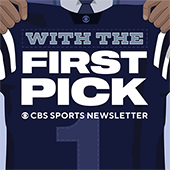
With The First Pick Newsletter
With The First Pick Newsletter
Prepare for the upcoming NFL Draft with the day’s big stories + mock drafts, big board updates and more.
Thanks for signing up!
Keep an eye on your inbox.
Sorry!
There was an error processing your subscription.
Antoine Green, WR, North Carolina
Green is the "other" receiver at North Carolina, with Josh Downs a likely second-round pick. But there is a lot to like about Green. He has good size at 6-foot-2 and 198 pounds to go along with the deep speed for a longer receiver, getting timed at 4.44 in the 40. Green is a long strider who can get down the field in a hurry. He averaged 18.6 yards on his 43 catches last season after averaging 19.1 yards per catch the previous season. He is far from a polished receiver, and there are drops. But he has the raw ability to be a guy who can come in and compete for a fourth- or fifth-receiver spot as a rookie. If he gets with the right receiver coach, one who can improve his footwork, he could develop into a deep threat who could also do something more on shorter routes. That's his problem now: his inability to be more than just a one-trick pony. But it's hard to ignore that size-speed combination.
Jack Campbell, LB, Iowa
He has all the tools to be a long-term NFL starter who makes a lot of plays. A few years ago, Logan Wilson of the Cincinnati Bengals was on my Better-Than team, and that's what Campbell can be at the next level. At 6-foot-5 and 249 pounds, he has the size to hold up as a true inside/MIKE linebacker. He is physical, and he does a great job diagnosing plays. He was timed at 4.65 in the 40 at the combine, so the speed is solid. He can sometimes get over-aggressive on tape, which is a concern. But this is a player who will start in the NFL for a long time. He made a ton of plays at Iowa, and he will do so in the NFL for whichever team takes him. Lately, there has been talk of him potentially going in the first round. He has that type of ability for sure.
Mazi Smith, DT, Michigan
There is a chance Smith will be a first-round pick, but I think he has the tools to become a Pro Bowl player, even if he doesn't go in the first. He is strong and can push the pocket. There are times when he has lapses during a game, but the right coach will get that out of him. At his best, he's a force against the run who can also rush the passer. Smith's best football is in front of him. At 6-foot-3 and 323 pounds, he has good size and power. He does have a tendency to wear down in games, which means he has to be in better shape. The traits are all there.
Rejzohn Wright, CB, Oregon State
At 6-2 and 195 pounds, he is one of the few corners in this draft with great size. He showed the ability to excel in both man and zone for Oregon State. The one issue that pops up for him is that quicker, smaller receivers can give him problems, which is what many taller corners struggle with at times. He's also a little grabby in his coverage, which has to change at the next level. But I think he can fit in with any scheme, and be a corner who can hold up if asked to play man or zone. He has 24 starts the past two seasons for the Beavers. His brother, Nahshon Wright, was a third-round pick of the Cowboys last year.
Jarrick Bernard-Converse, CB, LSU
If teams are looking for a down-the-line corner/safety, Bernard-Converse is that guy. He ran a 4.4 40 at nearly 6-foot-1 and 200 pounds at his pro day, which shows he has the tools. He started 47 games at Oklahoma State in four years before transferring to LSU last season, where he started all 13 games. That's 60 starts against top-level competition. He played both corner and safety last year, which shows his versatility; in a lean safety class, it might make sense to move him there full-time. He can also help on special teams. There's a play against Mississippi State where he chased down a kick returner from behind, making up a lot of ground to do so. Bare minimum, a team that drafts him will be getting a good special teams player with a lot of tools to become a contributor in the secondary.
Luke Schoonmaker, TE, Michigan
For any team looking for a quality blocker at the tight end position, Schoonmaker is one of those players. At 6-foot-5 and 251 pounds, he could add some more strength to become an even better blocker. He's more than willing to mix it up, which is always a good sign. He holds his own, even against defensive ends. As a receiver, the talent is there, although he isn't a guy who is going to take the top off. He wasn't asked to do a lot in the Michigan passing game, but I think he's more than capable of becoming a better receiver at the next level. Think Dalton Schultz.
Nathaniel Dell, WR, Houston
Dell might be the second-best route-runner in the class behind USC's Jordan Addison. He is polished in the way he sets up a defensive back, but he also can fly. The knock on him is his size. He's small at 5-foot-8 and 165 pounds, but he should be able to function as a slot receiver in the NFL. He's also a really good return man, which adds value right away. In the Houston offense, he was its go-to productive player, leading the nation in catches with 102 to go with 15 touchdowns. He was timed at 4.49, so he has the speed to get down the field. If only he were a little bigger.
Sam LaPorta, TE, Iowa
When you are doing a work up on a tight end, there is nothing more complimentary in today's game than saying he runs his routes like a receiver. That's LaPorta. Playing in a terrible offense at Iowa, due to awful quarterback play, LaPorta was still able to flash his pass-catching skills. He is a player who should be considered as the first tight end taken; that's how valuable he will be as a receiver at the next level. He is a willing blocker, and not a bad one, but he needs to get stronger to improve in that area. But that's not why you would draft him. You draft him so when he becomes a 75-catch tight end -- which he will -- you can check off that part of your offensive needs.
Jakorian Bennett, CB, Maryland
He isn't getting the fanfare that teammate Deonte Banks is at the corner position, but Bennett has a lot of skills that teams love. He can line up and run with receivers, showing off his 4.3 speed. At nearly 6-feet tall and 188 pounds, he's a lean corner, but the speed shows up. Bennett can also do a nice job in zone coverage, but he will make his money with his ability to play man. He isn't quite as talented as Banks, but for a third or fourth-round pick, he would make a lot of sense for a team in need of a cover player. His best football is ahead of him.
DeWayne McBride, RB, UAB
Teams looking for a runner who was productive in college should take a look at McBride. He is strong, can break tackles, and has a knack for getting through the initial contact, but he also ripped off a lot of big plays. He averaged 7.4 yards per rush last season on 233 carries. He only caught five passes in his career, so that is something he has to work on in the NFL. But as a runner, he has the tools to be a nice backup and maybe develop into more.
Marvin Mims, WR, Oklahoma
It's all about the speed and big play for Mims. He was timed at 4.38 in the 40, but more impressive is that he averaged more than 20 yards per catch the past two seasons on his 86 receptions. Mims can be a slot receiver at the next level, but he has the speed to move outside and create some problems in man coverage for defenses if a team wants to use him that way. He is smallish at 5-foot-11 1/2 and 183 pounds, but that's similar to Santonio Holmes when the Steelers drafted him out of Ohio State. Despite his size, Mims had no problems going over the middle and holding onto the football when taking hits. He does need to be more nimble in the middle of the field to help get open against NFL corners. You can't just rely on speed, but a good receiver coach will do him wonders. Speed kills, and he has it.
Keaton Mitchell, RB, East Carolina
Pop on any East Carolina game from last year, and you will see a blur making plays from the running back position. That was Mitchell. He is an explosive runner who can turn short runs into big plays. He has the speed to run away from defenders, clocking in at 4.37 at the scouting combine. The problem is he's just 5-foot-9 and 179 pounds. That's small. That's also why a team will have to scheme him up in its offense. He's not going to be a consistent between-the-tackles runner, although he can do it. He's also a capable return man, which will help his value. In an NFL game where space is now even more important, he should be able to flourish as a big-play runner. He does need to improve his receiving skills, and he won't be great in pass protection because of his size, but that speed and the ability to make defenses hold their collective breath when he carries it are the reasons why he will be a great value pick.
Dorian Thompson-Robinson, QB, UCLA
I always try to put a later-round quarterback on my list. No, I did not have Brock Purdy last year. But this year's pick is Thompson-Robinson. He isn't a big quarterback at 6-foot-2 and 203 pounds, but he is bigger than a certain quarterback named Young who will go first or second overall. A lot bigger, in fact. Thomson-Robinson was coached by Chip Kelly at UCLA, and he put up some impressive numbers. He has a good enough arm. In fact, he tied Josh Allen for the fastest throw in combine history at 62 mph, even if he didn't show that zip all the time at UCLA. By watching him throw at the combine, you can see he's spent a lot of time working on his mechanics, which have improved. He can also run, which he sometimes leaned on too much at UCLA. I see him as a backup who could end up being a spot starter -- and maybe more.
Habakkuk Baldonado, EDGE, Pitt
He has a great story since he is from Rome, Italy, and only played football for one year in the United States as a prep player before going to Pitt. He did play football in Italy against adults in an Italian league, so he has experience as a younger player. At Pitt, he was never a dominant edge player, but the traits are there as he continues to learn the game. At 6-foot-4 and 251 pounds, he has the frame to add more weight, which will help at the next level. He is a capable pass-rusher, but you can tell there is a lot to learn. I love players like this on Day 3, guys with tremendous upside. When watching tape of Pitt defensive tackle Calijah Kancey, I noticed Baldonado and the effort and strength he played with, even if he wasn't explosive. He only had two sacks last season, but he had nine in 2021. The best is yet to come for him.
Clark Phillips III, CB, Utah
He is 5-foot-9 and 185 pounds, and he didn't run under 4.5, which is why some see him as third-day player. I think whoever gets him will be getting a competitive corner who held up in the Pac-12 with his ability to play man and lock onto receivers. He is a prototypical nickel corner who will make up for lack of size and speed with his coverage skills and techniques and competitive nature. Sometimes guys are just good football players. Phillips is one of those guys, despite his limitations. Think Mike Hilton of the Bengals. That's Phillips.
Bennett Williams, S, Oregon
Corner Christian Gonzalez is the star in the Ducks secondary, a sure first-round pick, but Williams also flashed in a big way. Williams has been a two-year starter for Oregon after transferring from junior college. He was at junior college after leaving Illinois because of some off-field issues. He was a true freshman starter for the Illini, which says a lot about his talent. At Oregon, he lined up in a variety of spots, showing his ability to play a lot of positions. At 6-foot and 206 pounds, he doesn't have great speed at 4.6, but he plays faster than that. He has a knack for getting to the football. He's also good in the run game. He had two interceptions against Utah, one while jumping inside on a pass intended for possible first-round tight end Dalton Kincaid. He reminds me of a poor man's Tyrann Mathieu with his ability to play a lot of spots. He is worth a look as a late-round pick.
Demario Douglas, WR, Liberty
When watching Malik Willis tape last year, I kept seeing No. 3 doing a lot of good things catching his passes. It was Douglas, so I kept an eye on him this season. He proved to be more than just a beneficiary of playing with Willis. He had another good season in 2022, catching 79 passes compared to 52 last season. His tape against Arkansas was impressive. The only real knock on him is his size since he's 5-foot-9 and 178 pounds. But he runs good routes and he has good speed, timing at 4.4 in the 40. He plays that fast, too. He can also return punts.
Carter Warren, T, Pitt
This is a player who caught my eye in 2021 when I was watching Kenny Pickett. He was really good that season at left tackle. He returned last season, but was limited to four games because of a knee injury. At 6-foot-5 1/2 and 311 pounds, he has the size teams want in a tackle. He's good in pass protection, but needs to get stronger at the point in the run game. With 39 starts in his career, there is a lot of experience. He would make a lot of sense as a fourth- or fifth-round pick. He can help a team as a swing tackle and eventually become a starter.
Antonio Johnson, S, Texas A&M
At 6-foot-1 and 200 pounds, Johnson has good size for the position. He needs it the way he throws his body around. He is a physical player who is really good near the line of scrimmage. He is an aggressive tackler who has a nose for the football. He packs a punch when he tackles. As far as coverage, his aggressive approach can get him in trouble. There is a play against Auburn where he gets sucked up in the run game on a play-action pass that would have been a long TD if not for the pass being under-thrown. It ended up being a pass-interference penalty on Johnson as he scrambled to make the play. Those are the things in his game that need cleaning up, but he has the tools to be a starting safety who will pack a heck of a punch for the secondary.













